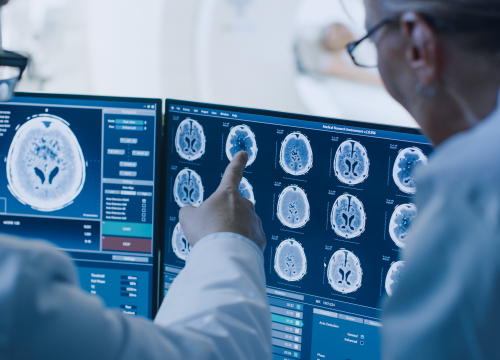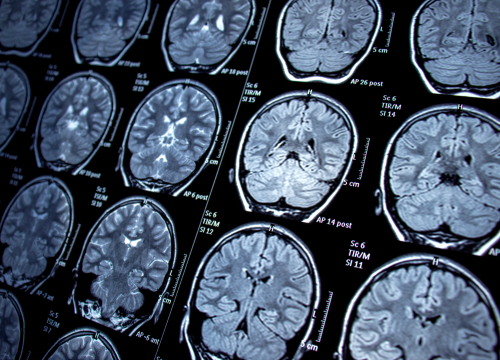Difference Between CT Scan and MRI Scan
A CT or computed tomography scan is a diagnostic radiologic modality that uses X-rays to give a detailed sophisticated 3-dimensional view of the human organs. A CT scan sometimes uses a contrast dye injected into the veins to give a better view of the localized region.
MRI or magnetic resonance imaging uses radio waves to give a better detailed view of the human body. It gives information on soft tissue and bone injury or diseases in a comprehensive and better way than a CT scan.

What is a CT scan?
Definition:
A CT or computed tomography scan is a diagnostic radiologic modality that uses X-rays to give a detailed sophisticated 3-dimensional view of the human organs. A CT scan sometimes uses a contrast dye injected into the veins to give a better view of the localized region.
Position:
A CT scan machine is a sliding table with a hollow cylinder in which the patient lies down and moves in and out. The machines throw X-rays at various angles and take hundreds of cross-sectional images of the human body. A technician in another room keeps giving instructions through a microphone and speaker.
Types:
PET scan and CT urography are two types of CT scans. A PET scan or positron emission tomography uses a radioactive tracer that is taken up by hyperfunctioning or disease regions of the body and later the uptake image is produced. CT urography highlights any abnormalities or lesions in the urogenital system of the body.
Radiation:
A CT scan uses X-rays to generate images of the inside of the human body.
Pros:
CT scan is an easily available investigation that can give information about inflammation, tumors, or injuries of the internal organs.
Cons:
CT scan is an expensive investigation. Although rare allergic or life-threatening reactions to the CT contrast dye have also been documented in some people. Kidney damage due to contrast dye is also a complication of CT scans.

What is an MRI scan?
Definition:
MRI or magnetic resonance imaging uses radio waves to give a better detailed view of the human body. It gives information on soft tissue and bone injury or diseases in a comprehensive and better way than a CT scan.
Position:
Supine or prone positions of the patient are used while doing an MRI scan.
Types:
Types of MRI scans include functional MRI which detects blow flow changes in the brain, magnetic resonance angiography/venography (MRA) which visualizes blood vessels, and cardiac MRI which gives images of the heart
Radiation:
MRI scans use a strong magnetic field to generate pictures of the human organs.
Pros:
MRI can detect pathologies that CT scans cannot. Certain prostate cancer, liver disorders, and uterine carcinomas do not show up on a CT scan. Metastasis to the brain and bone is easily missed on CT scans. Soft tissue trauma and joint and ligament injuries can easily be picked up on MRI scans.
Cons:
MRI is a long process that takes up to 40 minutes to be completed. This is cumbersome and inconvenient, especially for claustrophobic people. It is a noisy procedure so ear protection is given to people undergoing MRI scans.
Difference Between CT Scan and MRI
Definition:
A CT or computed tomography scan is a diagnostic radiologic modality that uses X-rays to give a detailed sophisticated 3-dimensional view of the human organs. A CT scan sometimes uses a contrast dye injected into the veins to give a better view of the localized region.
MRI or magnetic resonance imaging uses radio waves to give a better detailed view of the human body. It gives information on soft tissue and bone injury or diseases in a comprehensive and better way than a CT scan.
Position:
A CT scan machine is a sliding table with a hollow cylinder in which the patient lies down and moves in and out. The machines throw X-rays at various angles and take hundreds of cross-sectional images of the human body. A technician in another room keeps giving instructions through a microphone and speaker.
Supine or prone positions of the patient are used while doing an MRI scan.
Types:
PET scan and CT urography are two types of CT scans. A PET scan or positron emission tomography uses a radioactive tracer that is taken up by hyperfunctioning or disease regions of the body and later the uptake image is produced. CT urography highlights any abnormalities or lesions in the urogenital system of the body. Types of MRI scans include functional MRI which detects blow flow changes in the brain, magnetic resonance angiography/venography (MRA) which visualizes blood vessels, and cardiac MRI which gives images of the heart.
Radiation:
A CT scan uses X-rays to generate images of the inside of the human body. MRI scans use a strong magnetic field to generate pictures of human organs.
Pros:
CT scan is an easily available investigation that can give information about inflammation, tumors, or injuries of the internal organs. MRI can detect pathologies that CT scans cannot. Certain prostate cancer, liver disorders, and uterine carcinomas do not show up on a CT scan. Metastasis to the brain and bone is easily missed on CT scans. Soft tissue trauma and joint and ligament injuries can easily be picked up on MRI scans.
Cons:
CT scan is an expensive investigation. Although rare allergic or life-threatening reactions to the CT contrast dye have also been documented in some people. Kidney damage due to contrast dye is also a complication of CT scans. MRI is a long process that takes up to 40 mins to be completed. This is cumbersome and inconvenient, especially for claustrophobic people. It is a noisy procedure so ear protection is given to people undergoing MRI scans.
Table of differences Between CT scan and MRI

FAQs
What does a CT scan show that an MRI does not?
Bone injuries and fractures are visualized better in a CT scan.
Which is better a CAT scan or MRI?
Each investigation has its pros. Each of the two becomes superior depending on the type of tissue needed to be viewed and the patient’s medical history.
Why would a doctor order both an MRI and a CAT scan?
Both investigations can be ordered for a comprehensive evaluation.
What does not show up on a CT scan?
Detailed soft tissue injuries, nerve ligaments, and certain tumors might be missed on a CT scan.
What is the most common reason for a CT scan?
It is used as an urgent investigation into head injuries and emergency conditions.
Which is more accurate CT scan or MRI?
MRI is more accurate than a CT scan.
- Differences Between Reptiles and Amphibians - May 17, 2024
- Difference Between Ophthalmology and Optometry - May 15, 2024
- Difference Between Fear and Anxiety - April 2, 2024
Search DifferenceBetween.net :
Leave a Response
References :
[0]Kalin, Ron, and Marshall S. Stanton. "Current clinical issues for MRI scanning of pacemaker and defibrillator patients." Pacing and clinical electrophysiology 28.4 (2005): 326-328.
[1]Patel, Paula R., and Orlando De Jesus. "CT Scan." StatPearls [Internet]. StatPearls Publishing, 2023.
[2]Kalender, Willi A. "X-ray computed tomography." Physics in Medicine & Biology 51.13 (2006): R29.
[3]Image credit: https://www.canva.com/photos/MADerPyTonw-in-control-room-doctor-and-radiologist-discuss-diagnosis-while-watching-procedure-and-monitors-showing-brain-scans-results-in-the-background-patient-undergoes-mri-or-ct-scan-procedure-/
[4]Image credit: https://www.canva.com/photos/MAES-TpRBzw-magnetic-resonance-imaging-mri-photosensitive-epilepsy-seizures-neurological-diseases/
